Analyzing the Implications of Globalization on Strategic HRM Practices
VerifiedAdded on 2022/09/09
|10
|2692
|25
Essay
AI Summary
This essay critically examines the implications of globalization on Strategic Human Resource Management (SHRM). It begins by defining SHRM and differentiating it from traditional HRM, exploring its historical development and key models like the Matching Model and Harvard Framework. The essay delves into the concept of strategy, strategic intent, and strategic problems, highlighting how globalization impacts marketing, funding, production, and HRM. It addresses strategic tensions in HRM, the formulation of HR strategy using rational and incremental models, and the linkages between strategy and HRM. The analysis further covers HR strategy content, process, and implementation, emphasizing organizational success through people and the characteristics of SHRM, including unitarist/pluralist and hard/soft HRM approaches. The essay also discusses the 'Best Fit' and 'Best Practice' approaches, the impact of globalization on employees, and the need for organizations to adapt to rapid changes by adopting flexible strategies. The paper concludes by highlighting the challenges and opportunities presented by globalization and the significance of people in the workplace, emphasizing the need for SHRM to align with business strategy to achieve a competitive advantage.

Implications Of Globalization1
IMPLICATIONS OF GLOBALIZATION
By (Student’s Name)
Professor’s Name
College
Couse
Date
IMPLICATIONS OF GLOBALIZATION
By (Student’s Name)
Professor’s Name
College
Couse
Date
Paraphrase This Document
Need a fresh take? Get an instant paraphrase of this document with our AI Paraphraser

Implications Of Globalization2
THE IMPLICATIONS OF GLOBALIZATION FOR SHRM
Introduction
Globalization remains a critical element that affects firms that compete with rivals for
consumers with high anticipations for low costs, quality, as well as performance. Global
movements of services, as well as goods, have increased for the past few years due to
globalization. Trade Obstacles have reduced with the arrival of FTZ (Free Trade Zone) in the
European Union, North America, Asia, and Europe. Many researchers argue that globalization
has allowed institutions to compete on the universal level. (Robinson et al. 2019).
Internationalization of the operations of a company can indeed make the company compete well
with its rivals under certain conditions. Agarwal and Qouyatahi (2018) argue that the presences
globalization can lead to competence advantage only when organizations incorporate local
market differences (LMD), realized GES (Global economies of scale), as well as the effective
distribution of knowledge as well as technology across the border. Sims (2019) found out that
best practices do not often translate to other diverse cultures. Research indicates that effective
international HRM remains positively linked to financial performance in many countries, such as
the United States and India. Nevertheless, the best practices of HRM cannot always be
distributed across nations due to organizational and cultural differences. Most of the
organizations attempt to balance the demand for standardized best practices of HRM across
different national boundaries to adapt to local practices as well as customs. This paper discusses
the implications of globalization for Strategic Human Resource Management.
Globalization indeed has implications on SHRM, which stand for Strategic Human
Resource Management. It can be described as the process of managing individuals on work with
optimistic style (Callaghan 2018). The SHRM has been established from various stages, starting
THE IMPLICATIONS OF GLOBALIZATION FOR SHRM
Introduction
Globalization remains a critical element that affects firms that compete with rivals for
consumers with high anticipations for low costs, quality, as well as performance. Global
movements of services, as well as goods, have increased for the past few years due to
globalization. Trade Obstacles have reduced with the arrival of FTZ (Free Trade Zone) in the
European Union, North America, Asia, and Europe. Many researchers argue that globalization
has allowed institutions to compete on the universal level. (Robinson et al. 2019).
Internationalization of the operations of a company can indeed make the company compete well
with its rivals under certain conditions. Agarwal and Qouyatahi (2018) argue that the presences
globalization can lead to competence advantage only when organizations incorporate local
market differences (LMD), realized GES (Global economies of scale), as well as the effective
distribution of knowledge as well as technology across the border. Sims (2019) found out that
best practices do not often translate to other diverse cultures. Research indicates that effective
international HRM remains positively linked to financial performance in many countries, such as
the United States and India. Nevertheless, the best practices of HRM cannot always be
distributed across nations due to organizational and cultural differences. Most of the
organizations attempt to balance the demand for standardized best practices of HRM across
different national boundaries to adapt to local practices as well as customs. This paper discusses
the implications of globalization for Strategic Human Resource Management.
Globalization indeed has implications on SHRM, which stand for Strategic Human
Resource Management. It can be described as the process of managing individuals on work with
optimistic style (Callaghan 2018). The SHRM has been established from various stages, starting
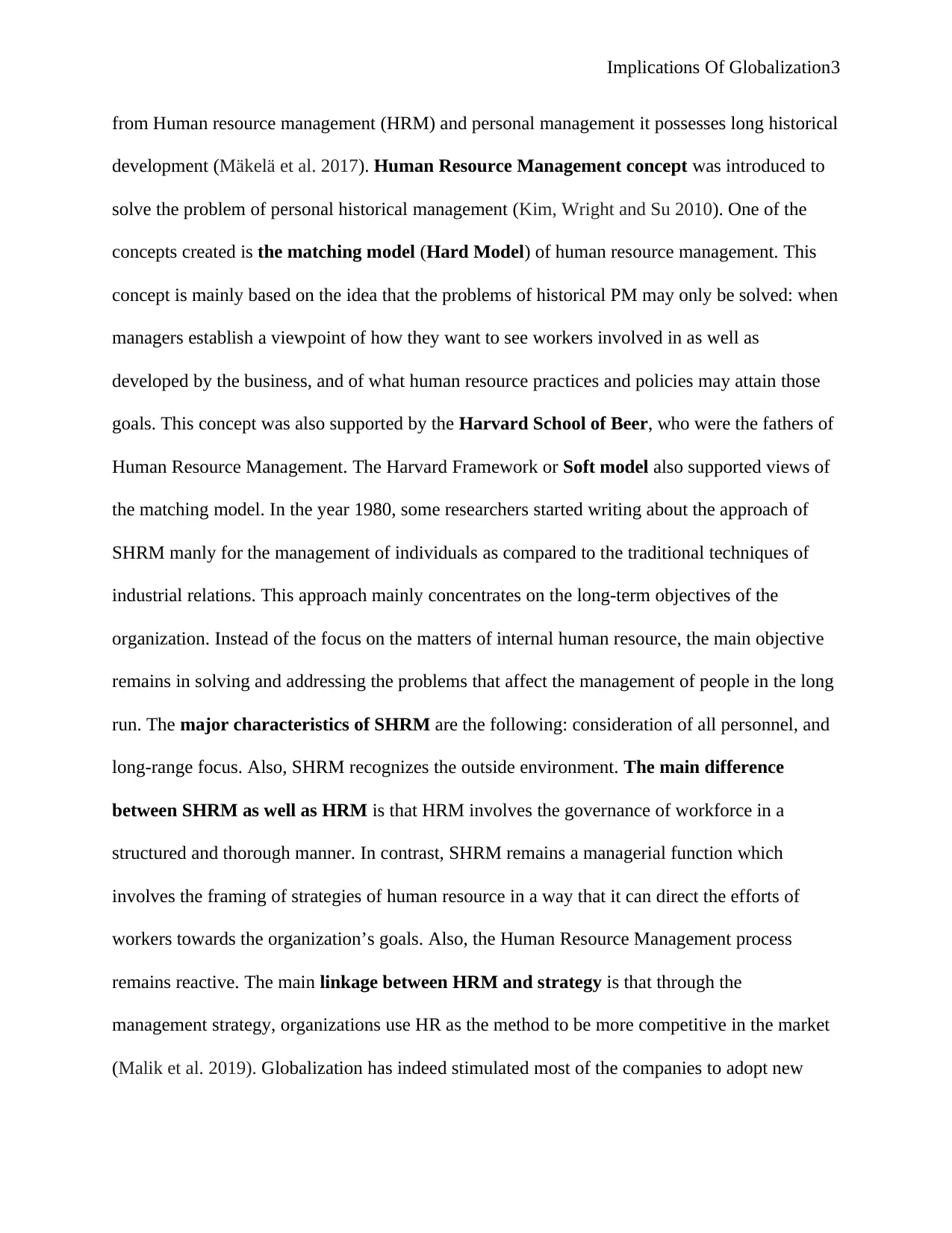
Implications Of Globalization3
from Human resource management (HRM) and personal management it possesses long historical
development (Mäkelä et al. 2017). Human Resource Management concept was introduced to
solve the problem of personal historical management (Kim, Wright and Su 2010). One of the
concepts created is the matching model (Hard Model) of human resource management. This
concept is mainly based on the idea that the problems of historical PM may only be solved: when
managers establish a viewpoint of how they want to see workers involved in as well as
developed by the business, and of what human resource practices and policies may attain those
goals. This concept was also supported by the Harvard School of Beer, who were the fathers of
Human Resource Management. The Harvard Framework or Soft model also supported views of
the matching model. In the year 1980, some researchers started writing about the approach of
SHRM manly for the management of individuals as compared to the traditional techniques of
industrial relations. This approach mainly concentrates on the long-term objectives of the
organization. Instead of the focus on the matters of internal human resource, the main objective
remains in solving and addressing the problems that affect the management of people in the long
run. The major characteristics of SHRM are the following: consideration of all personnel, and
long-range focus. Also, SHRM recognizes the outside environment. The main difference
between SHRM as well as HRM is that HRM involves the governance of workforce in a
structured and thorough manner. In contrast, SHRM remains a managerial function which
involves the framing of strategies of human resource in a way that it can direct the efforts of
workers towards the organization’s goals. Also, the Human Resource Management process
remains reactive. The main linkage between HRM and strategy is that through the
management strategy, organizations use HR as the method to be more competitive in the market
(Malik et al. 2019). Globalization has indeed stimulated most of the companies to adopt new
from Human resource management (HRM) and personal management it possesses long historical
development (Mäkelä et al. 2017). Human Resource Management concept was introduced to
solve the problem of personal historical management (Kim, Wright and Su 2010). One of the
concepts created is the matching model (Hard Model) of human resource management. This
concept is mainly based on the idea that the problems of historical PM may only be solved: when
managers establish a viewpoint of how they want to see workers involved in as well as
developed by the business, and of what human resource practices and policies may attain those
goals. This concept was also supported by the Harvard School of Beer, who were the fathers of
Human Resource Management. The Harvard Framework or Soft model also supported views of
the matching model. In the year 1980, some researchers started writing about the approach of
SHRM manly for the management of individuals as compared to the traditional techniques of
industrial relations. This approach mainly concentrates on the long-term objectives of the
organization. Instead of the focus on the matters of internal human resource, the main objective
remains in solving and addressing the problems that affect the management of people in the long
run. The major characteristics of SHRM are the following: consideration of all personnel, and
long-range focus. Also, SHRM recognizes the outside environment. The main difference
between SHRM as well as HRM is that HRM involves the governance of workforce in a
structured and thorough manner. In contrast, SHRM remains a managerial function which
involves the framing of strategies of human resource in a way that it can direct the efforts of
workers towards the organization’s goals. Also, the Human Resource Management process
remains reactive. The main linkage between HRM and strategy is that through the
management strategy, organizations use HR as the method to be more competitive in the market
(Malik et al. 2019). Globalization has indeed stimulated most of the companies to adopt new
⊘ This is a preview!⊘
Do you want full access?
Subscribe today to unlock all pages.

Trusted by 1+ million students worldwide
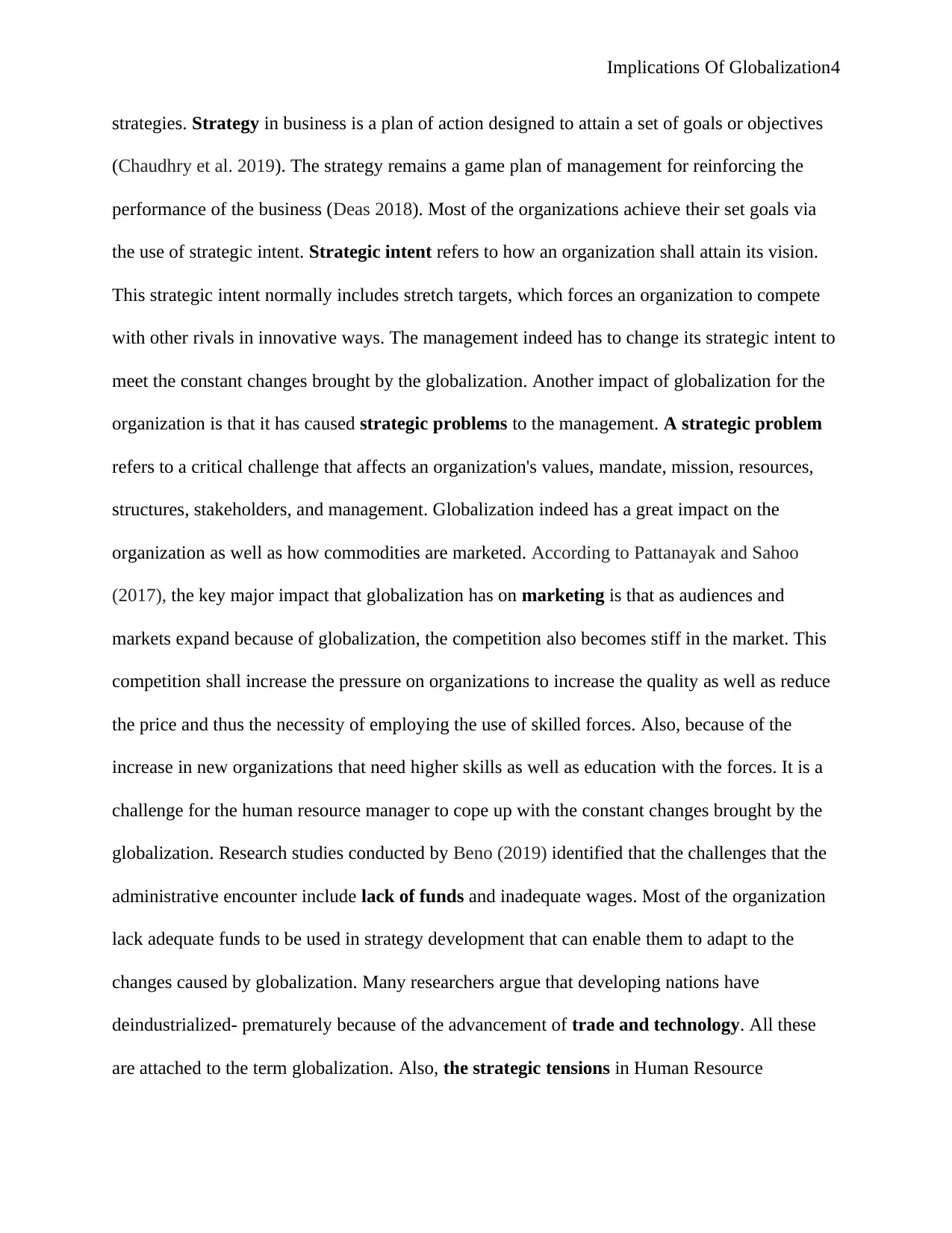
Implications Of Globalization4
strategies. Strategy in business is a plan of action designed to attain a set of goals or objectives
(Chaudhry et al. 2019). The strategy remains a game plan of management for reinforcing the
performance of the business (Deas 2018). Most of the organizations achieve their set goals via
the use of strategic intent. Strategic intent refers to how an organization shall attain its vision.
This strategic intent normally includes stretch targets, which forces an organization to compete
with other rivals in innovative ways. The management indeed has to change its strategic intent to
meet the constant changes brought by the globalization. Another impact of globalization for the
organization is that it has caused strategic problems to the management. A strategic problem
refers to a critical challenge that affects an organization's values, mandate, mission, resources,
structures, stakeholders, and management. Globalization indeed has a great impact on the
organization as well as how commodities are marketed. According to Pattanayak and Sahoo
(2017), the key major impact that globalization has on marketing is that as audiences and
markets expand because of globalization, the competition also becomes stiff in the market. This
competition shall increase the pressure on organizations to increase the quality as well as reduce
the price and thus the necessity of employing the use of skilled forces. Also, because of the
increase in new organizations that need higher skills as well as education with the forces. It is a
challenge for the human resource manager to cope up with the constant changes brought by the
globalization. Research studies conducted by Beno (2019) identified that the challenges that the
administrative encounter include lack of funds and inadequate wages. Most of the organization
lack adequate funds to be used in strategy development that can enable them to adapt to the
changes caused by globalization. Many researchers argue that developing nations have
deindustrialized- prematurely because of the advancement of trade and technology. All these
are attached to the term globalization. Also, the strategic tensions in Human Resource
strategies. Strategy in business is a plan of action designed to attain a set of goals or objectives
(Chaudhry et al. 2019). The strategy remains a game plan of management for reinforcing the
performance of the business (Deas 2018). Most of the organizations achieve their set goals via
the use of strategic intent. Strategic intent refers to how an organization shall attain its vision.
This strategic intent normally includes stretch targets, which forces an organization to compete
with other rivals in innovative ways. The management indeed has to change its strategic intent to
meet the constant changes brought by the globalization. Another impact of globalization for the
organization is that it has caused strategic problems to the management. A strategic problem
refers to a critical challenge that affects an organization's values, mandate, mission, resources,
structures, stakeholders, and management. Globalization indeed has a great impact on the
organization as well as how commodities are marketed. According to Pattanayak and Sahoo
(2017), the key major impact that globalization has on marketing is that as audiences and
markets expand because of globalization, the competition also becomes stiff in the market. This
competition shall increase the pressure on organizations to increase the quality as well as reduce
the price and thus the necessity of employing the use of skilled forces. Also, because of the
increase in new organizations that need higher skills as well as education with the forces. It is a
challenge for the human resource manager to cope up with the constant changes brought by the
globalization. Research studies conducted by Beno (2019) identified that the challenges that the
administrative encounter include lack of funds and inadequate wages. Most of the organization
lack adequate funds to be used in strategy development that can enable them to adapt to the
changes caused by globalization. Many researchers argue that developing nations have
deindustrialized- prematurely because of the advancement of trade and technology. All these
are attached to the term globalization. Also, the strategic tensions in Human Resource
Paraphrase This Document
Need a fresh take? Get an instant paraphrase of this document with our AI Paraphraser
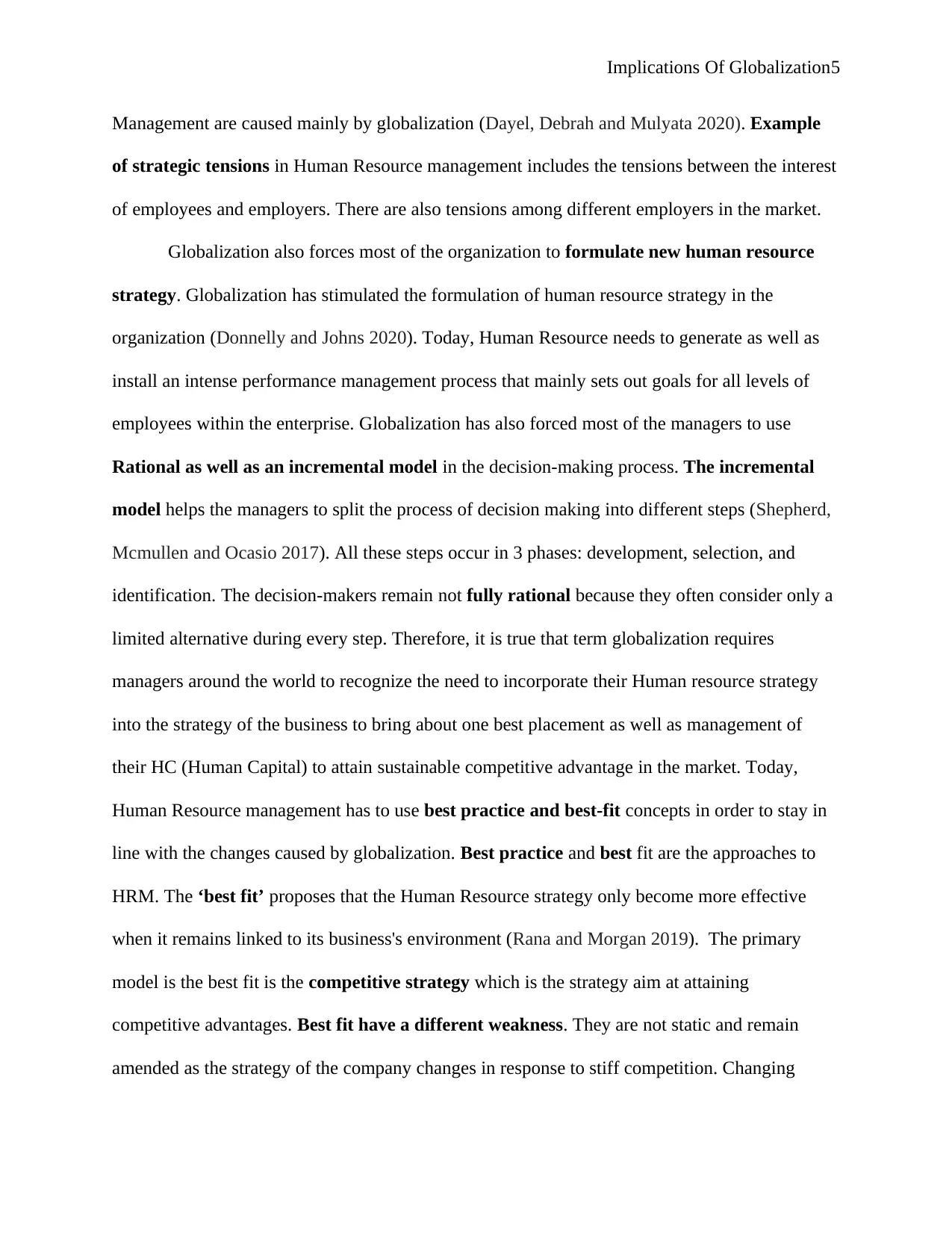
Implications Of Globalization5
Management are caused mainly by globalization (Dayel, Debrah and Mulyata 2020). Example
of strategic tensions in Human Resource management includes the tensions between the interest
of employees and employers. There are also tensions among different employers in the market.
Globalization also forces most of the organization to formulate new human resource
strategy. Globalization has stimulated the formulation of human resource strategy in the
organization (Donnelly and Johns 2020). Today, Human Resource needs to generate as well as
install an intense performance management process that mainly sets out goals for all levels of
employees within the enterprise. Globalization has also forced most of the managers to use
Rational as well as an incremental model in the decision-making process. The incremental
model helps the managers to split the process of decision making into different steps (Shepherd,
Mcmullen and Ocasio 2017). All these steps occur in 3 phases: development, selection, and
identification. The decision-makers remain not fully rational because they often consider only a
limited alternative during every step. Therefore, it is true that term globalization requires
managers around the world to recognize the need to incorporate their Human resource strategy
into the strategy of the business to bring about one best placement as well as management of
their HC (Human Capital) to attain sustainable competitive advantage in the market. Today,
Human Resource management has to use best practice and best-fit concepts in order to stay in
line with the changes caused by globalization. Best practice and best fit are the approaches to
HRM. The ‘best fit’ proposes that the Human Resource strategy only become more effective
when it remains linked to its business's environment (Rana and Morgan 2019). The primary
model is the best fit is the competitive strategy which is the strategy aim at attaining
competitive advantages. Best fit have a different weakness. They are not static and remain
amended as the strategy of the company changes in response to stiff competition. Changing
Management are caused mainly by globalization (Dayel, Debrah and Mulyata 2020). Example
of strategic tensions in Human Resource management includes the tensions between the interest
of employees and employers. There are also tensions among different employers in the market.
Globalization also forces most of the organization to formulate new human resource
strategy. Globalization has stimulated the formulation of human resource strategy in the
organization (Donnelly and Johns 2020). Today, Human Resource needs to generate as well as
install an intense performance management process that mainly sets out goals for all levels of
employees within the enterprise. Globalization has also forced most of the managers to use
Rational as well as an incremental model in the decision-making process. The incremental
model helps the managers to split the process of decision making into different steps (Shepherd,
Mcmullen and Ocasio 2017). All these steps occur in 3 phases: development, selection, and
identification. The decision-makers remain not fully rational because they often consider only a
limited alternative during every step. Therefore, it is true that term globalization requires
managers around the world to recognize the need to incorporate their Human resource strategy
into the strategy of the business to bring about one best placement as well as management of
their HC (Human Capital) to attain sustainable competitive advantage in the market. Today,
Human Resource management has to use best practice and best-fit concepts in order to stay in
line with the changes caused by globalization. Best practice and best fit are the approaches to
HRM. The ‘best fit’ proposes that the Human Resource strategy only become more effective
when it remains linked to its business's environment (Rana and Morgan 2019). The primary
model is the best fit is the competitive strategy which is the strategy aim at attaining
competitive advantages. Best fit have a different weakness. They are not static and remain
amended as the strategy of the company changes in response to stiff competition. Changing

Implications Of Globalization6
policies and expectations may be frustrating for workers (Gallardo, Thunnissen and Scullion
2017).
On the other hand, the model of Best-practice claims that some bundles of Human
Resource activities exist which globally support in enhancing any performance of the
organization in realizing a competitive advantage irrespective of the organizational setting
(Maniora 2017). The seven (7) best practices preferred by Pfeffer include employment
security, self-management team, selective hiring, sharing information, reduction of status
differentials, high compensation on performance, and training to offer a skilled as well as the
motivated workforce (Krishnan and Scullion 2017). The major problem with best practice is
that it can result in standardized Human Resource practices that remain suboptimal at the unit
level. It is true that globalization has forced institutions to stop the old system and practices that
have been evolved for the past few years. The practices that remain acceptable locally can be at
odds with the company’s values as well as the laws of the regulatory agencies.
Globalization has also impacted employees in the organization. It is true that a greater
implication of globalization is on training as a strategy used by the organizations to boost their
performance (Tung 2016). Training remains an activity that mainly cultivates professionalism in
the employees. Globalization demand for efficient and trained workers and this raise attention on
training in many organizations around the world. Training concentrated on the needs as well as
professional competency of employees. Most of the companies have to change their strategy,
which they initially used on training because of globalization. Also, the other challenge for
Human Resource is to create policies and strategies that abide by the norms and culture of all the
countries (Mackay and Zundel 2017).
policies and expectations may be frustrating for workers (Gallardo, Thunnissen and Scullion
2017).
On the other hand, the model of Best-practice claims that some bundles of Human
Resource activities exist which globally support in enhancing any performance of the
organization in realizing a competitive advantage irrespective of the organizational setting
(Maniora 2017). The seven (7) best practices preferred by Pfeffer include employment
security, self-management team, selective hiring, sharing information, reduction of status
differentials, high compensation on performance, and training to offer a skilled as well as the
motivated workforce (Krishnan and Scullion 2017). The major problem with best practice is
that it can result in standardized Human Resource practices that remain suboptimal at the unit
level. It is true that globalization has forced institutions to stop the old system and practices that
have been evolved for the past few years. The practices that remain acceptable locally can be at
odds with the company’s values as well as the laws of the regulatory agencies.
Globalization has also impacted employees in the organization. It is true that a greater
implication of globalization is on training as a strategy used by the organizations to boost their
performance (Tung 2016). Training remains an activity that mainly cultivates professionalism in
the employees. Globalization demand for efficient and trained workers and this raise attention on
training in many organizations around the world. Training concentrated on the needs as well as
professional competency of employees. Most of the companies have to change their strategy,
which they initially used on training because of globalization. Also, the other challenge for
Human Resource is to create policies and strategies that abide by the norms and culture of all the
countries (Mackay and Zundel 2017).
⊘ This is a preview!⊘
Do you want full access?
Subscribe today to unlock all pages.

Trusted by 1+ million students worldwide
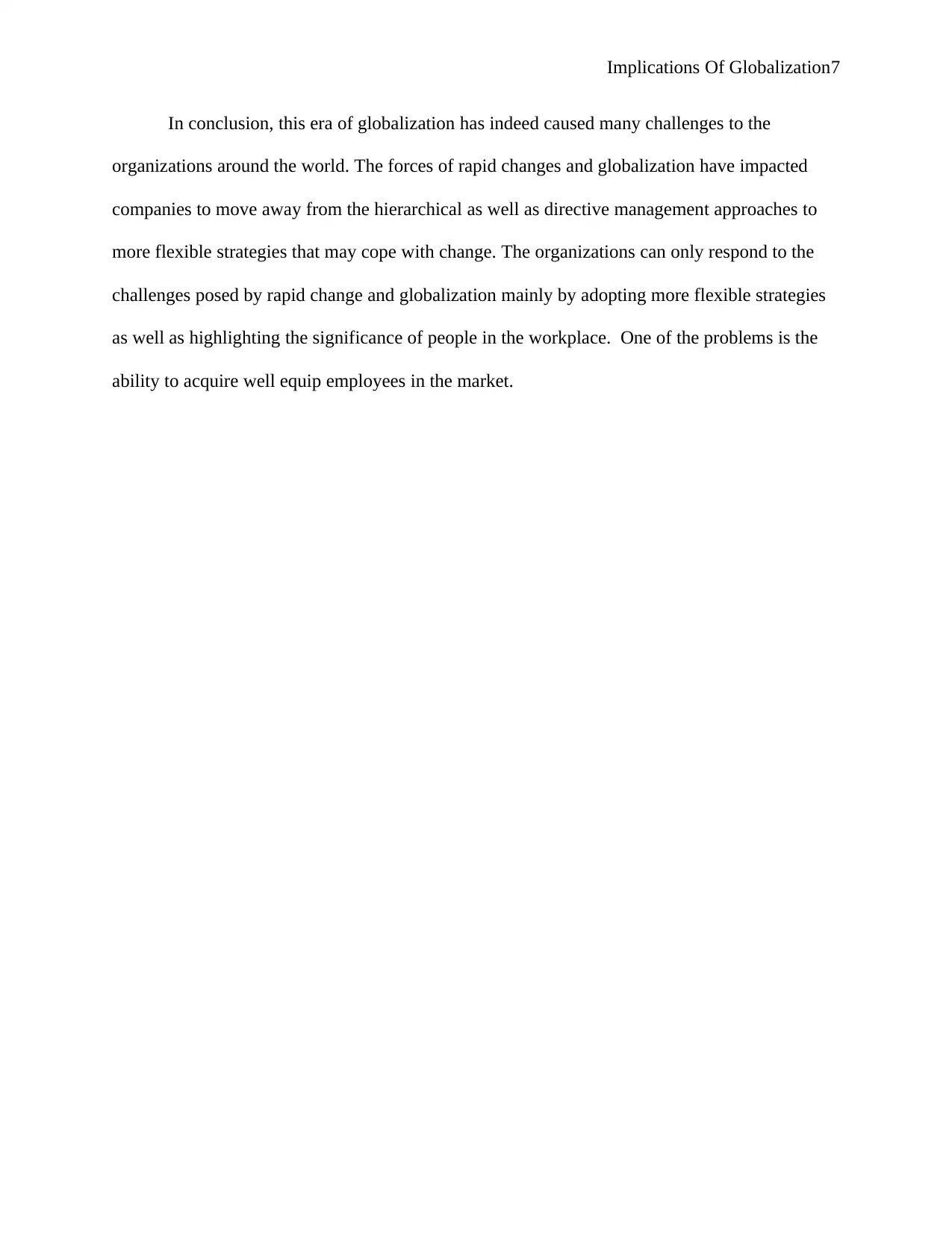
Implications Of Globalization7
In conclusion, this era of globalization has indeed caused many challenges to the
organizations around the world. The forces of rapid changes and globalization have impacted
companies to move away from the hierarchical as well as directive management approaches to
more flexible strategies that may cope with change. The organizations can only respond to the
challenges posed by rapid change and globalization mainly by adopting more flexible strategies
as well as highlighting the significance of people in the workplace. One of the problems is the
ability to acquire well equip employees in the market.
In conclusion, this era of globalization has indeed caused many challenges to the
organizations around the world. The forces of rapid changes and globalization have impacted
companies to move away from the hierarchical as well as directive management approaches to
more flexible strategies that may cope with change. The organizations can only respond to the
challenges posed by rapid change and globalization mainly by adopting more flexible strategies
as well as highlighting the significance of people in the workplace. One of the problems is the
ability to acquire well equip employees in the market.
Paraphrase This Document
Need a fresh take? Get an instant paraphrase of this document with our AI Paraphraser

Implications Of Globalization8
References
Agarwal, S. and Al Qouyatahi, K.M.S., 2018. HRM Challenges in the Age of
Globalisation. International Research Journal of Business Studies, 10(2), pp.89-98.
Beno, M., 2019, April. The Four Major Factors Impacting on the Future of Work. In World
Conference on Information Systems and Technologies (pp. 12-24). Springer, Cham.
Callaghan, C.W., 2018. Strategic human resources management or talent management: a
theoretical non sequitur?. Journal of Contemporary Management, 15(1), pp.763-783.
Chaudhry, N.I., Aftab, I., Arif, Z., Tariq, U. and Roomi, M.A., 2019. Impact of customer-
oriented strategy on financial performance with mediating role of HRM and innovation
capability. Personnel Review.
Dayel, W.A., Debrah, Y.A. and Mulyata, J., 2020. To Explore the Effect of Talent Management
Developments in Saudi Healthcare Sector. Management, 8(1), pp.1-13.
Deas, A., 2018. Managing Diversity in Talent Retention: Implications of Psychological Contract,
Career Preoccupations and Retention Factors. In Psychology of Retention (pp. 331-351).
Springer, Cham.
Donnelly, R. and Johns, J., 2020. Recontextualising remote working and its HRM in the digital
economy: An integrated framework for theory and practice. The International Journal of Human
Resource Management, pp.1-22.
Gallardo-Gallardo, E., Thunnissen, M. and Scullion, H., 2017. Special issue of international
journal of human resource management. A contextualized approach to talent management:
advancing the field.
Kim, S., Wright, P.M. and Su, Z., 2010. Human resource management and firm performance in
China: A critical review. Asia Pacific Journal of Human Resources, 48(1), pp.58-85.
References
Agarwal, S. and Al Qouyatahi, K.M.S., 2018. HRM Challenges in the Age of
Globalisation. International Research Journal of Business Studies, 10(2), pp.89-98.
Beno, M., 2019, April. The Four Major Factors Impacting on the Future of Work. In World
Conference on Information Systems and Technologies (pp. 12-24). Springer, Cham.
Callaghan, C.W., 2018. Strategic human resources management or talent management: a
theoretical non sequitur?. Journal of Contemporary Management, 15(1), pp.763-783.
Chaudhry, N.I., Aftab, I., Arif, Z., Tariq, U. and Roomi, M.A., 2019. Impact of customer-
oriented strategy on financial performance with mediating role of HRM and innovation
capability. Personnel Review.
Dayel, W.A., Debrah, Y.A. and Mulyata, J., 2020. To Explore the Effect of Talent Management
Developments in Saudi Healthcare Sector. Management, 8(1), pp.1-13.
Deas, A., 2018. Managing Diversity in Talent Retention: Implications of Psychological Contract,
Career Preoccupations and Retention Factors. In Psychology of Retention (pp. 331-351).
Springer, Cham.
Donnelly, R. and Johns, J., 2020. Recontextualising remote working and its HRM in the digital
economy: An integrated framework for theory and practice. The International Journal of Human
Resource Management, pp.1-22.
Gallardo-Gallardo, E., Thunnissen, M. and Scullion, H., 2017. Special issue of international
journal of human resource management. A contextualized approach to talent management:
advancing the field.
Kim, S., Wright, P.M. and Su, Z., 2010. Human resource management and firm performance in
China: A critical review. Asia Pacific Journal of Human Resources, 48(1), pp.58-85.
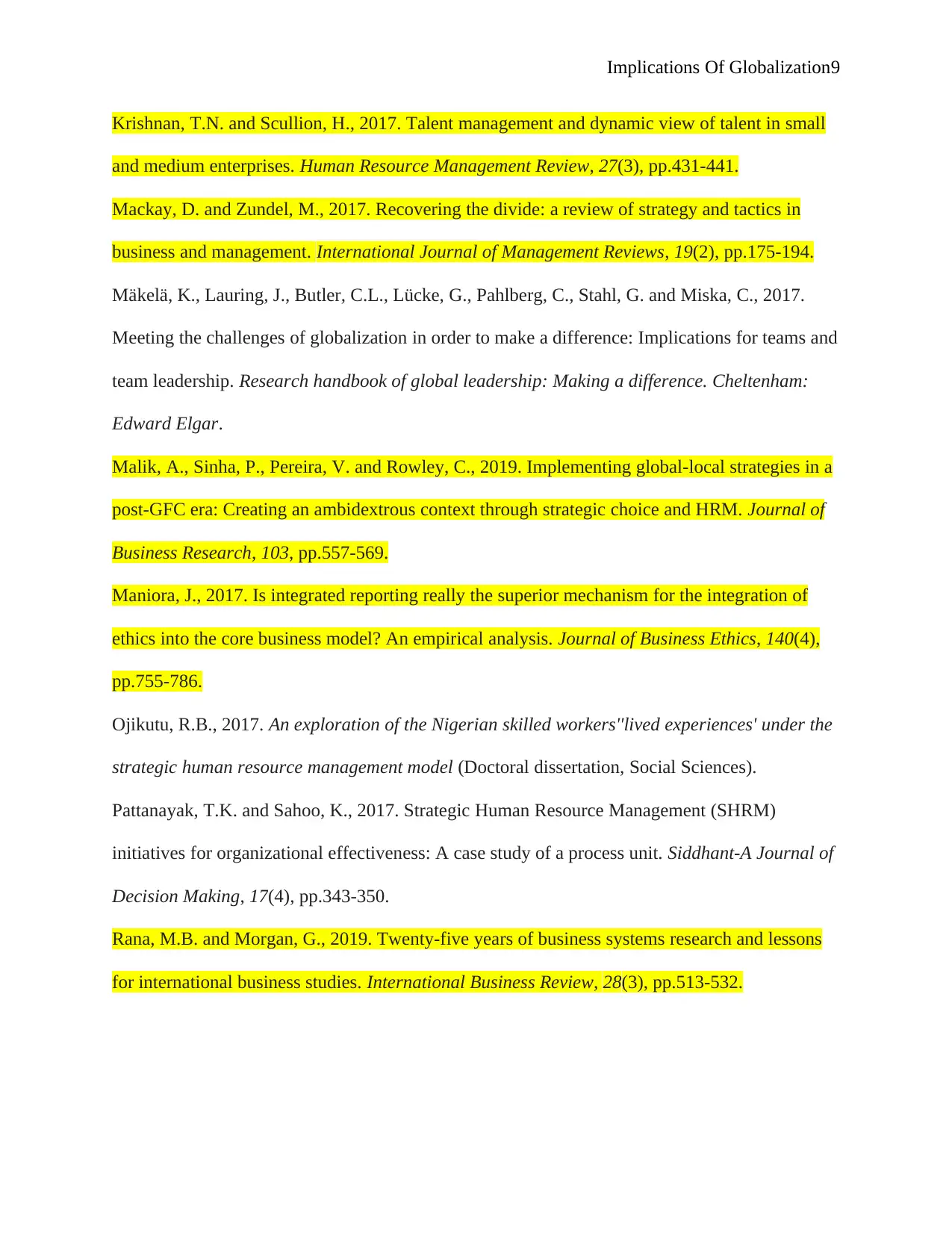
Implications Of Globalization9
Krishnan, T.N. and Scullion, H., 2017. Talent management and dynamic view of talent in small
and medium enterprises. Human Resource Management Review, 27(3), pp.431-441.
Mackay, D. and Zundel, M., 2017. Recovering the divide: a review of strategy and tactics in
business and management. International Journal of Management Reviews, 19(2), pp.175-194.
Mäkelä, K., Lauring, J., Butler, C.L., Lücke, G., Pahlberg, C., Stahl, G. and Miska, C., 2017.
Meeting the challenges of globalization in order to make a difference: Implications for teams and
team leadership. Research handbook of global leadership: Making a difference. Cheltenham:
Edward Elgar.
Malik, A., Sinha, P., Pereira, V. and Rowley, C., 2019. Implementing global-local strategies in a
post-GFC era: Creating an ambidextrous context through strategic choice and HRM. Journal of
Business Research, 103, pp.557-569.
Maniora, J., 2017. Is integrated reporting really the superior mechanism for the integration of
ethics into the core business model? An empirical analysis. Journal of Business Ethics, 140(4),
pp.755-786.
Ojikutu, R.B., 2017. An exploration of the Nigerian skilled workers''lived experiences' under the
strategic human resource management model (Doctoral dissertation, Social Sciences).
Pattanayak, T.K. and Sahoo, K., 2017. Strategic Human Resource Management (SHRM)
initiatives for organizational effectiveness: A case study of a process unit. Siddhant-A Journal of
Decision Making, 17(4), pp.343-350.
Rana, M.B. and Morgan, G., 2019. Twenty-five years of business systems research and lessons
for international business studies. International Business Review, 28(3), pp.513-532.
Krishnan, T.N. and Scullion, H., 2017. Talent management and dynamic view of talent in small
and medium enterprises. Human Resource Management Review, 27(3), pp.431-441.
Mackay, D. and Zundel, M., 2017. Recovering the divide: a review of strategy and tactics in
business and management. International Journal of Management Reviews, 19(2), pp.175-194.
Mäkelä, K., Lauring, J., Butler, C.L., Lücke, G., Pahlberg, C., Stahl, G. and Miska, C., 2017.
Meeting the challenges of globalization in order to make a difference: Implications for teams and
team leadership. Research handbook of global leadership: Making a difference. Cheltenham:
Edward Elgar.
Malik, A., Sinha, P., Pereira, V. and Rowley, C., 2019. Implementing global-local strategies in a
post-GFC era: Creating an ambidextrous context through strategic choice and HRM. Journal of
Business Research, 103, pp.557-569.
Maniora, J., 2017. Is integrated reporting really the superior mechanism for the integration of
ethics into the core business model? An empirical analysis. Journal of Business Ethics, 140(4),
pp.755-786.
Ojikutu, R.B., 2017. An exploration of the Nigerian skilled workers''lived experiences' under the
strategic human resource management model (Doctoral dissertation, Social Sciences).
Pattanayak, T.K. and Sahoo, K., 2017. Strategic Human Resource Management (SHRM)
initiatives for organizational effectiveness: A case study of a process unit. Siddhant-A Journal of
Decision Making, 17(4), pp.343-350.
Rana, M.B. and Morgan, G., 2019. Twenty-five years of business systems research and lessons
for international business studies. International Business Review, 28(3), pp.513-532.
⊘ This is a preview!⊘
Do you want full access?
Subscribe today to unlock all pages.

Trusted by 1+ million students worldwide

Implications Of Globalization10
Robinson, J., Sritharan, V., Saravanabawan, A., Kengatharan, N., Sivaskaran, M.T., Prahalathan,
M.B., Vaikunthavasan, M.S., Balagobei, M.S., Drucia, E., Panchanatham, N. and Opatha,
H.H.D.N., 2017. Journal of Business Studies.
Shepherd, D.A., Mcmullen, J.S. and Ocasio, W., 2017. Is that an opportunity? An attention
model of top managers' opportunity beliefs for strategic action. Strategic Management
Journal, 38(3), pp.626-644.
Sims, R.R., 2019. Globalization and Human resource management. Human Resources
Management Issues, Challenges and Trends:" Now and Around the Corner", p.31.
Tung, R.L., 2016. New perspectives on human resource management in a global context. Journal
of World Business, 51(1), pp.142-152.
Robinson, J., Sritharan, V., Saravanabawan, A., Kengatharan, N., Sivaskaran, M.T., Prahalathan,
M.B., Vaikunthavasan, M.S., Balagobei, M.S., Drucia, E., Panchanatham, N. and Opatha,
H.H.D.N., 2017. Journal of Business Studies.
Shepherd, D.A., Mcmullen, J.S. and Ocasio, W., 2017. Is that an opportunity? An attention
model of top managers' opportunity beliefs for strategic action. Strategic Management
Journal, 38(3), pp.626-644.
Sims, R.R., 2019. Globalization and Human resource management. Human Resources
Management Issues, Challenges and Trends:" Now and Around the Corner", p.31.
Tung, R.L., 2016. New perspectives on human resource management in a global context. Journal
of World Business, 51(1), pp.142-152.
1 out of 10
Related Documents
Your All-in-One AI-Powered Toolkit for Academic Success.
+13062052269
info@desklib.com
Available 24*7 on WhatsApp / Email
![[object Object]](/_next/static/media/star-bottom.7253800d.svg)
Unlock your academic potential
Copyright © 2020–2025 A2Z Services. All Rights Reserved. Developed and managed by ZUCOL.





